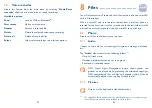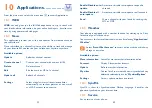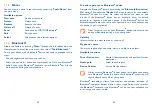
59
60
I am unable to send and receive mms
•
Check your phone memory availability as it might be full
•
Contact your network operator to check service availability and check MMS
parameters (see page 21)
•
Verify the server center number or your MMS profile with your operator
•
The server center may be swamped, try again later
The flickering
icon is displayed on my standby screen
•
You have saved too many short messages on your SiM card; delete some of
them or archive them in the phone memory
sIm card PIN locked
•
Contact your network operator to obtain the PuK code (Personal
unblocking Key)
I am unable to download new files
•
Make sure there is sufficient phone memory for your download
•
Select the microSD card as the location to store downloaded files
•
Check your subscription status with your operator
The phone cannot be detected by others via Bluetooth
®
•
Make sure that Bluetooth
®
is turned on and your phone is visible to other
users (see page 43)
•
Make sure that the two phones are within the detection range
How to make your battery last longer
•
Make sure you follow the complete charge time (minimum 3 hours)
•
After a partial charge, the battery level indicator may not be exact. Wait for
at least 20 minutes after removing the charger to obtain an exact indication
•
Switch on the backlight upon request
•
update news and weather information on manual demand, or decrease the
frequency of the auto-check feature
•
Deactivate Bluetooth
®
when not in use
safety and use .............................
We recommend that you read this chapter carefully before using your cellphone. The manufacturer
disclaims any liability for damage, which may result as a consequence of improper use or use
contrary to the instructions contained herein.
TRaFFIC saFETY:
Given that studies show that using a cellphone while driving a vehicle constitutes a real risk, even
when the hands-free kit is used (car kit, headset, etc.), drivers are requested to refrain from using
their cellphone when the vehicle is not parked. Check the laws and regulations on the use of
wireless cellphones and their accessories in the areas where you drive. Always obey them. The use
of these devices may be prohibited or restricted in certain areas.
When driving, do not use your cellphone and headphones to listen to music or to the radio. using
a headphones can be dangerous and forbidden in some areas.
When switched on, your cellphone emits electromagnetic waves that can interfere with the vehicle’s
electronic systems such as ABS anti-lock brakes or airbags. To ensure that there is no problem:
•
Do not place your cellphone on top of the dashboard or within an airbag deployment area.
•
Check with your car dealer or the car manufacturer to make sure that the car’s electronic devices
are shielded from cellphone RF energy.
CONDITIONs OF usE:
You are advised to switch off the cellphone from time to time to optimize its performance.
Remember to abide by local authority rules of cellphone use on aircrafts.
Operational Warnings: Obey all posted signs when using mobile devices in public areas.
Follow instructions to Avoid interference Problems: Turn off your mobile device in any location
where posted notices instruct you to do so. in an aircraft, turn off your mobile device whenever
instructed to do so by airline staff. if your mobile device offers an airplane mode or similar feature,
consult airline staff about using it in flight.
Switch the cellphone off when you are in health care facilities, except in designated areas. As with many
other types of equipment now in regular use, cellphones can interfere with other electrical or electronic
devices, or equipment using radio frequency.
Switch the cellphone off when you are near gas or flammable liquids. Strictly obey all signs and
instructions posted in a fuel depot, gas station, or chemical plant, or in any potentially explosive
atmosphere.
When the cellphone is switched on, it should be kept at least 15 cm from any medical device such
as a pacemaker, a hearing aid or insulin pump. When using the cellphone, you should hold it against
the ear on the opposite side of the device.
Read and follow the directions from the manufacturer of your medical device. if you have any
questions about using your mobile device with your medical device, consult your healthcare
provider.
To avoid hearing impairment, answer the call before holding your cellphone to your ear. Also move
the handset away from your ear while using the “speaker” option because the amplified volume
might cause hearing damage.
it is recommended to have proper supervision while small children use your cellphone.
When replacing the cover please note that your cellphone may contain substances that could create
an allergic reaction.
Always handle your cellphone with care and keep it in a clean and dust-free place.
Do not allow your cellphone to be exposed to adverse weather or environmental conditions





































